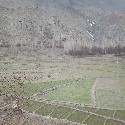8th Wonder of the World (KKH) sheydjs ahdke shagri
KKH - known as KaraKuram Highway is the road which connects China and Pakistan crossing a huge mountain series. The total length of the KKH is approximately 1300 km, with 887 km in Pakistan and 413 km in China. Why it has been dubbed Eighth Wonder of the World? lets explore it.... It starts from Havelian and winds through many beautiful spots such as Mansehra, Thakot, Abbottabad, Besham, Pattan, Sazin, Chils, Gilgit Baltistan and Hunza, connecting China's Xinjiang region with Pakistan's Gilgit–Baltistan region in Khyber Pakhtunkhwa at an altitude of 4,693 m/15,397 ft. The twisted path comes across miles and miles of barren land with rocky mountains staring you in the face. It has more than 20,000 bits of rock art along the expressway that are assembled at 10 sites in the middle of Hunza and Shatial. Riding along the highway to take in the spectacular view becomes extremely dangerous at various points as the paved international highway has been cut through the highest and the mightiest mountains of the world, The Himalayas and The Karakoram. The Karakoram Highway possesses a long history. In the late 1800s, the Russians, Chinese and British empire all had their eyes on the northern areas, yet access to this area was not easy. To maintain their hold over the northern territories, it became necessary that the British Empire improve their communication infrastructure. After surveying the area, it became clear that the only all-weather approach to the area was along the Indus. The British, aware of the difficulties of building a new road, simply improved an old Srinagar foot track into a mule track. Later on, a second route was developed for pack animals passing through Chilas over the Babusar Pass into the Kaghan Valley. But this route was open for only three months a year and could not be used as a primary means of transportation. After partition, the Srinagar route was blocked and the second route was the only land route available linking the Northern Areas with the rest of Pakistan. In 1958, a modest project by the name of Indus Valley Road (IVR) was inducted. The idea was to provide an all-weather road link between Swat and Gilgit. In 1966, under a Sino-Pak agreement, the government decided to develop the IVR into the Karakoram Highway. Under phase one of the project, the KKH was to begin in Thakot, Pakistan, extend to the Khunjerab Pass located at the Pakistan-China border and then linked to the road on the Chinese side. Near to the completion of the KKH, it was decided that the entrance would shift to the city of Hassan Abdal. The KKH, with significant help from the Chinese, was completed in 1978. It is estimated that for almost every kilometer built, one man died, both Pakistani and Chinese. Yet the construction of Karakoram Highway has not only improved trade and tourism between Pakistan and China but has contributed significantly to the improvement in living standards of local population.







